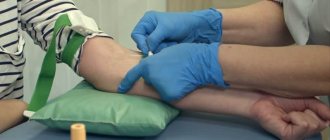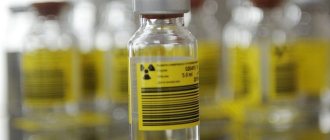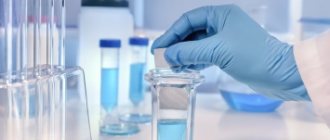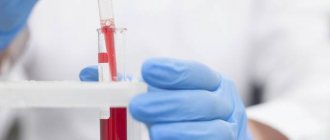Tumor markers are specific substances found in the blood and urine, which can be both waste products of the tumor and substances synthesized by healthy cells in response to the invasion of cancer cells. Detection of tumor markers in the body makes it possible to diagnose the oncological process at an early stage and monitor the dynamics of pathology during treatment.
Who needs to be tested for tumor markers?
People whose relatives have been diagnosed with tumors of various locations should take tests for tumor biomarkers as screening tests 1–2 times a year.
People who have benign tumors (adenoma, myoma, fibroma) or tumor-like formations (kidney cysts, ovarian cysts) need to be examined with the same frequency. The rest can be tested for tumor markers once every 2-3 years.
People who have undergone cancer therapy should be tested for tumor biomarkers: every month during the first year, once every 2 months during the second year, once every 3 months during the third to fifth year. Five years after cancer treatment, it is sufficient to undergo tumor marker testing once every 6–12 months.
Tumor biomarkers can be detected in urine, blood, prostatic juice, fluid taken from the pleura or abdominal cavity. Specific antibodies are added to a sample of biological fluid taken from the patient. They form specific complexes with the protein structure of the tumor marker, which are identified by laboratory methods. Non-protein tumor biomarkers are determined by other methods.
Our clinics in St. Petersburg
Structural subdivision of Polikarpov Alley Polikarpov 6k2 Primorsky district
- Pionerskaya
- Specific
- Commandant's
Structural subdivision of Zhukov Marshal Zhukov Ave. 28k2 Kirovsky district
- Avtovo
- Avenue of Veterans
- Leninsky Prospekt
Structural subdivision Devyatkino Okhtinskaya alley 18 Vsevolozhsk district
- Devyatkino
- Civil Prospect
- Academic
For detailed information and to make an appointment, you can call +7 (812) 640-55-25
Make an appointment
A benign or malignant neoplasm secretes a special cancer antigen. In this regard, when different tumors arise in the body, their own tumor markers appear. Tumor marker studies are also carried out in case of diagnosis of the disease and its treatment. It will allow doctors to choose subsequent tactics and, if necessary, prescribe additional drugs.
Most frequently identified tumor markers
75% of cancer patients have elevated alpha-fetoprotein (AFP) levels. Most often it is elevated in liver cancer; also, its high level can indicate testicular and ovarian cancer (in 5% of cases).
The tumor marker beta-2-microglobulin indicates the development of lymphoma and multiple myeloma. Markers CA 27-29, CA 15-3 indicate possible breast cancer, CA 125 - ovarian cancer. Biomarkers LASA-P, CA 72-4 make one suspect the presence of ovarian cancer and gastrointestinal tumors. The CA 19-9 marker is detected in cancer of the pancreas.
Types of tumor diseases
Cancer is a very old disease, which was first described back in 1600 BC. e. The name cancer itself was introduced by Hippocrates. These malignant tumors arise due to the transformation of normal cells, which begin to multiply uncontrollably. If the immune system does not begin to recognize the presence of a tumor in time, then metastases develop in all tissues and organs. Benign tumors, in turn, are distinguished by the fact that they do not metastasize, and therefore they do not pose a danger to life, however, at the same time, the possibility of degeneration of a benign tumor into a malignant one remains. The final diagnosis can be made after histological examination. Without the necessary treatment, malignant tumors can lead to the death of the affected person.
Symptoms of a tumor disease can vary and depend on the location of the tumor. In the early stages, the tumor does not cause any sensation, and pain appears only in the later stages. The most common symptoms are:
- loss of appetite;
- weight loss;
- exhaustion;
- anemia;
- immunopathological conditions;
- the occurrence of unusual compactions and swellings;
- inflammation;
- jaundice;
- bleeding.
With metastases, depending on where they develop, bone pain occurs and bone fractures often occur; cough (sometimes with blood); the liver and lymph nodes enlarge, etc.
Malignant tumors are divided into the following types (depending on the cells from which they are formed): carcinoma, sarcoma, melanoma, lymphoma, leukemia, glioma, teratoma, choriocarcinoma, etc.
According to international studies, the most common types of cancer are identified:
- Lung cancer ranks first in both the number of cases and the number of deaths from it. The first symptoms appear in the form of hemoptysis, chest pain, weakness, decreased performance, and cough. The main cause of the disease is smoking tobacco. There are four stages in the development of the disease:
- on the first, the tumor is up to 3 cm and is located in only one segment of the lung;
- in the second, the tumor is up to 6 centimeters, also located in one part of the organ. Metastases develop;
- in the third, the tumor reaches a size of more than six centimeters and is already beginning to move to the adjacent lobe of the lung. Metastases have more obvious manifestations;
- at the fourth stage, the cancer extends beyond the organ and spreads to neighboring organs.
Treatment for lung cancer can be carried out using various methods and is prescribed depending on the state of health, the extent of the disease and many other factors.
- Mammary cancer . This disease ranks second in terms of the number of patients and fifth in terms of mortality from it. Mostly the female half of the population suffers from breast cancer. The risk group includes women who have not given birth, as well as those who had their first birth after 30, and smokers. Also an important role is played by the presence of a family history, diabetes mellitus, hypertension and obesity. Symptoms of breast cancer:
- seals;
- various discharge from the nipple;
- change in the structure or color of the breast.
- The third place in the number of cases is colon cancer.
- Although stomach cancer ranks fourth in terms of incidence of diseases, it is in second place in terms of mortality.
Tumor marker monitoring
Monitoring the dynamics of tumor markers plays an important role in cancer therapy. This allows you to determine the effectiveness of treatment and timely adjust its regimen. For example, during chemotherapy and radiation therapy, it is possible to increase the level of markers, which does not indicate an exacerbation of the process, but rather lysis of the tumor. Together with other indicators, biomarkers make it possible to monitor the patient’s health status during therapy and at its end.
You can get tested for tumor markers at the Medical Genetics Center.
When to donate blood for markers and how to prepare
Let us immediately note that what a blood test for tumor markers shows is not a diagnosis. This is only the first step, which can carry up to 95% of what is happening in the body. Therefore, checking the oncoprotein norm is always accompanied by other examination methods, in particular, magnetic resonance and computed tomography, ultrasound, and radiography.
The main indications for analysis are:
| Diagnosis of early detection of cancerous compaction. |
| Checking for the presence of metastases in the absence of any symptoms. |
| Drawing up the most suitable and effective treatment program for cancer, selecting medications and their dosages. |
| Monitoring and evaluating the effectiveness of the chosen treatment program and the effectiveness of the drugs used. |
Testing the normal level of tumor markers is prescribed for risk groups and people over 50 years of age, since the production of these substances increases with age.
Please note that a blood test for tumor markers in women and men is taken only for each type separately, as prescribed by the doctor. Depending on the suspected location of the tumor, testing only one marker may be sufficient to identify it. But more often than not, the complete picture is provided by the group that best fits together.
Preparation in most cases does not require special actions, and it is almost similar to the requirements for a blood biochemistry test:
| Refusal to eat 4-12 hours before the procedure. You should also exclude coffee, tea and juices. Only non-carbonated water is acceptable, including on the day of blood collection. |
| Stop using medications in consultation with your doctor. If this is not possible, you should definitely notify the laboratory assistant about this. |
| Avoid alcohol and smoking 12 hours before the start (this also applies to hookah, smoking various aromatic tobaccos and electronic cigarettes). |
| Try not to visit a massage therapist or undergo diagnostic manipulations several hours before testing. |
| Reduce physical activity. Enough leisurely walks. |
It is also necessary, if possible, to prevent stressful situations and not to be nervous. Remember that compliance with these requirements will allow you to obtain high-quality and reliable results.
Women need to plan the analysis based on the period of the menstrual cycle. An appropriate specialist will help you choose the right day when your hormonal levels are optimal.
Preparing for analysis
To diagnose cancer using a blood test, material is taken from a vein. In this case, the conditions for storing the serum before the study must be observed, and it must be carried out no later than an hour after collection.
If at the time of the analysis there are signs of inflammation, then you need to report this, as the test results may become false positive. It is better to carry it out a week after the process has subsided. The same applies to the period of menstruation.
You should not drink alcohol the day before the test.
Taking ascorbic acid, some hormonal drugs, nitrates and other medications can also affect the level of OM. The doctor will tell you how long before the test you should stop taking them.
It is better to take all subsequent tests in the same laboratory so that the dynamics can be assessed.
What other tumor markers are used to diagnose cancer?
For dynamic monitoring of patients during treatment, OM is determined, which can indicate the effectiveness of the treatment, confirm the radicality of tumor removal or the occurrence of a second tumor.
To confirm the effectiveness of therapy, predictive and pharmacogenetic tests are required. Thus, it is mandatory to determine the tumor markers KRAS and EGFR in tumor tissue. This analysis will help you choose a drug for chemotherapy. In the presence of a mutant KRAS gene, the use of monoclonal antibodies for targeted therapy of colorectal cancer is absolutely ineffective. On the other hand, a positive test result for an EGFR mutation may be the basis for the prescription of anti-EGFR drugs (for non-small cell lung cancer - NSCLC).
To predict and diagnose tumor aggressiveness in breast cancer, HER2 is determined. If the test is positive, the tumor cells will be most sensitive to the drug Herceptin.
The EML4-ALK fusion test in NSCLC helps determine the sensitivity of cancer cells to crizotinib. This has increased survival and freedom from relapse in patients with this aggressive cancer.
In melanoma, it is important to analyze mutations in the BRAF V600E gene, the positive result of which indicates the effectiveness of vemurafenib in such patients. This test also launched a series of developments of targeted drugs for the treatment of resistant forms of the disease.
Sources
- Inaba S., Shimozono N., Yabuki H., Enomoto M., Morishita M., Hirotsu T., di Luccio E. Accuracy evaluation of the C. elegans cancer test (N-NOSE) using a new combined method. // Cancer Treat Res Commun - 2021 - Vol27 - NNULL - p.100370; PMID:33901923
- Huang Z., Chen L., Wang Y., Fu L., Lv R. Molecular markers, pathology, and ultrasound features of invasive breast cancer. // Clin Imaging - 2021 - Vol79 - NNULL - p.85-93; PMID:33895560
- Qiu X., Zhang H., Zhao Y., Zhao J., Wan Y., Li D., Yao Z., Lin D. Application of circulating genetically abnormal cells in the diagnosis of early-stage lung cancer. // J Cancer Res Clin Oncol - 2021 - Vol - NNULL - p.; PMID:33893839
- Zhang Y., Wu Q., Xu L., Wang H., Liu X., Li S., Hu T., Liu Y., Peng Q., Chen Z., Wu X., Fan JB. Sensitive detection of colorectal cancer in peripheral blood by a novel methylation assay. // Clin Epigenetics - 2021 - Vol13 - N1 - p.90; PMID:33892797
- Koshiaris C., Van den Bruel A., Nicholson BD., Lay-Flurrie S., Hobbs FR., Oke JL. Clinical prediction tools to identify patients at highest risk of myeloma in primary care: a retrospective open cohort study. // Br J Gen Pract - 2021 - Vol - NNULL - p.; PMID:33824161
- Chantzichristos D., Svensson PA., Garner T., Glad CA., Walker BR., Bergthorsdottir R., Ragnarsson O., Trimpou P., Stimson RH., Borresen SW., Feldt-Rasmussen U., Jansson PA., Skrtic S., Stevens A., Johannsson G. Identification of human glucocorticoid response markers using integrated multi-omic analysis from a randomized crossover trial. // Elife - 2021 - Vol10 - NNULL - p.; PMID:33821793
- Lewin J., Kottwitz D., Aoyama J., deVos T., Garces J., Hasinger O., Kasielke S., Knaust F., Rathi P., Rausch S., Weiss G., Zipprich A., Mena E. ., Fong T.L. Plasma cell free DNA methylation markers for hepatocellular carcinoma surveillance in patients with cirrhosis: a case control study. // BMC Gastroenterol - 2021 - Vol21 - N1 - p.136; PMID:33765926
- Chiancone F., Fabiano M., Carrino M., Fedelini M., Meccariello C., Fedelini P. Impact of systemic inflammatory markers on the response to Hyperthermic IntraVEsical Chemotherapy (HIVEC) in patients with non-muscle-invasive bladder cancer after bacillus Calmette-Guérin failure. // Arab J Urol - 2021 - Vol19 - N1 - p.86-91; PMID:33763253
- Ladak Z., Garcia E., Yoon J., Landry T., Armstrong EA., Yager JY., Persad S. Sulforaphane (SFA) protects neuronal cells from oxygen & glucose deprivation (OGD). // PLoS One - 2021 - Vol16 - N3 - p.e0248777; PMID:33735260
- Chen C., Yang H., Cai D., Xiang L., Fang W., Wang R. Preoperative peripheral blood neutrophil-to-lymphocyte ratios (NLR) and platelet-to-lymphocyte ratio (PLR) related nomograms predict the survival of patients with limited-stage small-cell lung cancer. // Transl Lung Cancer Res - 2021 - Vol10 - N2 - p.866-877; PMID:33718028
Tumor marker PSA (prostate-specific prostate antigen, total and free)
PSA is present in healthy, overdeveloped and transformed prostate tissue. It is the most specific and sensitive antigen for diagnosing prostate cancer . For research, blood is taken before biopsy, removal or massage of the prostate, because Mechanical irritation of the gland can cause an increase in PSA levels that lasts up to 3 weeks. The PSA norm is 0-4 ng/ml, a level of 10 ng/ml and above indicates a malignant disease.
How to prepare for a PSA blood test?
-no food is allowed within 8 hours before the test; juice, tea, coffee, alcohol are excluded;
- it is recommended to abstain from sexual intercourse for 5-7 days before the study;
— it is advisable to take the test before an examination by a urologist or 10-14 days after it;
- after a prostate massage or digital rectal examination, cystoscopy or catheterization of the bladder, transrectal ultrasound and after any other mechanical effects on the prostate, it is advisable to wait at least 2 weeks before taking a blood test for PSA, and after a biopsy
Increase in PSA :
Prostate cancer (about 80% of cases),
Benign prostatic hyperplasia (slight increase),
Inflammation or infection in the prostate
Ischemia or infarction of the prostate,
Ejaculation on the eve of the study,
Surgery, trauma, or prostate biopsy
glands.










